After four long years, the Chevrolet Bolt EV has its mid-cycle refresh with lots of asked for features and gains a new, bigger sibling with Super Cruise – the Chevrolet Bolt EUV.
The Chevrolet Bolt came out to much fanfare four years ago, quickly nabbing Motortrend’s Car of the Year award. It has been called the first long-range affordable electric vehicle, providing 238 EPA-rated miles of range when it came out in 2017, with a starting price of $37,495 ($29,995 after federal tax rebate). The Bolt has been successful in a market that few manufacturers are willing to enter, with more than 100,000 sold. Despite a rough 2019, 2020 sales surged by 26%, despite not having any federal tax credits. Drivers have amassed more than 1.2 billion all-electric miles.
Not just for leasing
EVs owners typically have a strong preference towards leasing, with nearly 80% of the industry’s customers leasing (excluding Tesla). As technology changes quickly, owners want to be able to jump to the next best thing without being tied down. However, the Bolt has succeeded with a much lower lease rate. A much higher than usual proportion of people bought the car, seeing themselves keeping it for a while.
High customer satisfaction
Chevrolet knows that current Bolt owners are strong supporters, and are very passionate about their cars. Despite its shortcomings, the Bolt has received among the highest customer satisfaction ratings in the industry. It attracts more new customers to GM than any of their other brands. To decide on what to do for the refresh and for the new EUV, GM reached out to their customers. Active on Facebook and Twitter, More than 3,000 one-on-one sessions with customers allowed them to find out what was wanted, and GM listened.
Everyone in
With their new “Everyone in” campaign, GM is finally trying to take electric vehicles to the masses, making it as simple and seamless an experience as owning a gas car.
How does this compare to our previous two predictions about how the car would turn out? Grab a cup of coffee, and let’s dive into the full in-depth review together! In addition, be sure to check out our video review!
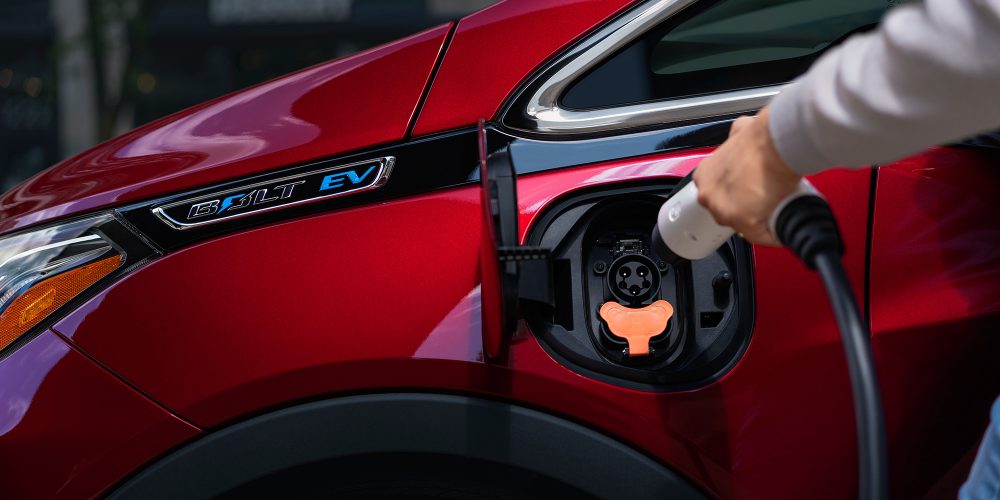
Tackling one of the biggest problems
One of the biggest hurdles to getting people into an electric vehicle was working out to charge their car at home.
The original Bolt came with 7.68kW level 2 onboard charging, providing a full charge in about 10 hours. The new Bolts come with upgraded “11kW” charging (likely 48A so 11.5kW). This provides up to 42 EPA-rated miles of charge per hour, or roughly 6.5 to 7 hours from empty to full.
Better included charging cable
One of the most common questions on the Bolt Owners Facebook Group is new owners asking “which charging cable should I get.” GM has listened, and will now include a new dual-voltage 7.2kW portable charge cord (presumably 32A 7.68kW). This will provide 25 EPA rated miles per hour of charge or 10 hours empty to full. This will be replacing the 120V 1.44kW that came with the first-gen Bolt EV. Likely 90% of owners never used it anyway, and many of the other 10% hacked into a 240V cable.
Home charging gets easier
Most importantly, and perhaps most impressively, GM has teamed up with qMerit to provide “standard” at-home charging installation included in the cost of the vehicle. For qualifying owners, the cost of an outlet will be covered. The included charge cord will be enough for the vast majority of owners, letting them plug in at night and leave in the morning with a full charge – the gold standard.
Not having to worry about or understand the intricacies of home charging will provide a much more seamless and relaxing buying experience for new EV drivers. Buy the Bolt, drive it, and plug it in when you get home.
A new model is born – the Bolt EUV
Trying to appeal to a wider base, Chevrolet has split the Bolt into two models – the same EV that we knew and loved from before, and a new Electric Utility Vehicle – EUV – breaking into the small SUV category.
What’s new for both?
Updated exterior styling.
Sportier and sleeker, the Bolt looks more serious now. A centerline crease is the same as before, with similar creases along the sides. The EV keeps a remarkably similar side-body to its older brethren, with the creases following the door handles in a line, but there is now a more pronounced protrusion lower along the door. The EUV has a similar lower protrusion, while the higher crease line runs just below the windows instead.
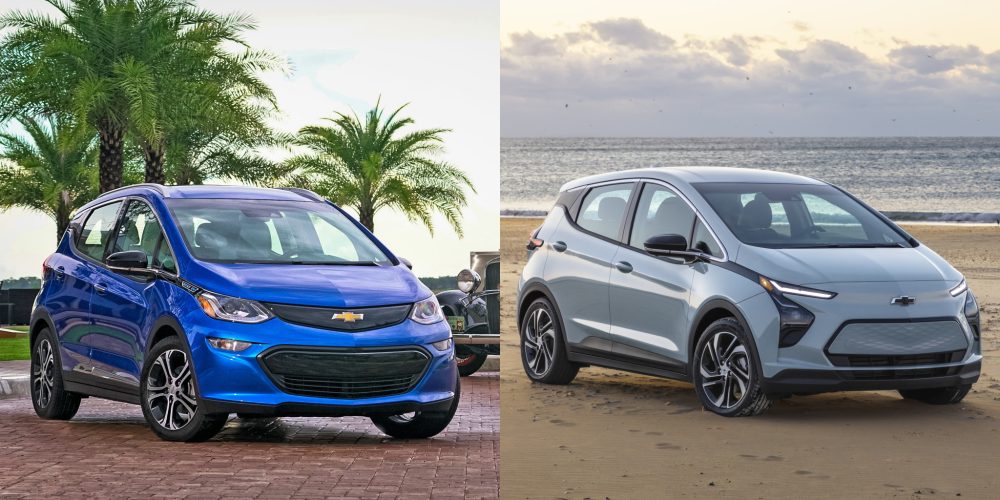
The redesign brings with it a distinct front fascia that is definitively more serious looking. Gone is the happy looking front with a black bar bridging the headlights and the stand-out gold bowtie. In its place is a more consistent, sterner façade, with a much closer-in-color lower grill and a lone center black emblem. New “high eye” LED daytime running lights squint under the hood, doubling as sequential turn signals. LED headlights replace the HID Xenon bulbs from the first generation, wrapping down around the sides. Combined, it now looks more like an electric vehicle than a gas one.
A vastly improved interior
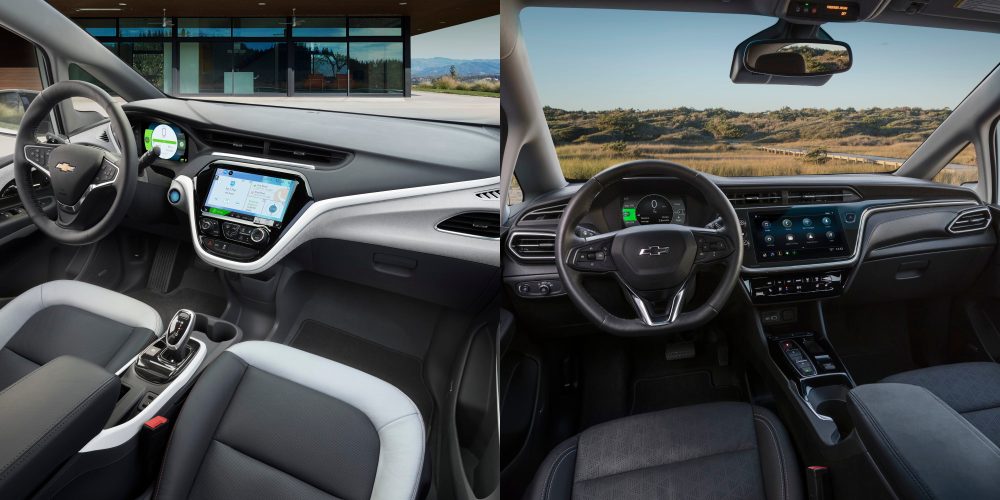
Perhaps the best part of the update is the vastly improved, more contemporary interior, with more “soft touch” fabric and surfaces. Gone is the cheap plastic feel of the first-generation Bolt, replaced with a much sleeker color-consistent premium feel, available in all black or two-tone grey. While everything is fundamentally in the same place, it all looks and feels streamlined and sexy.
New infotainment system
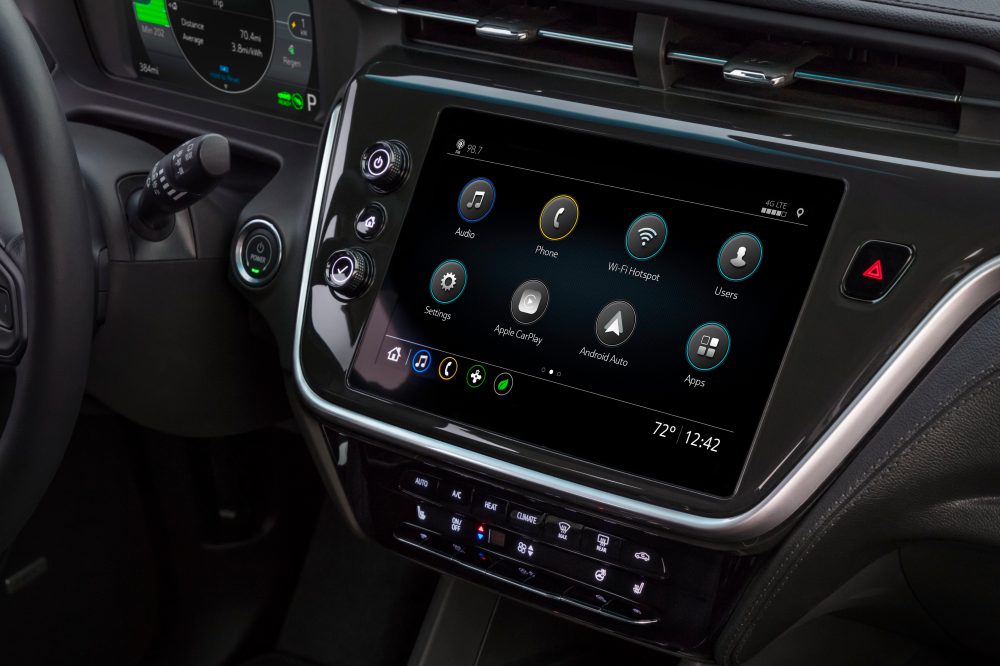
The “floating” infotainment system is replaced with a fully integrated unit flush in the dashboard. A 10.2” screen and simplified button layout promise an “all-new” user experience. Only two dials and three buttons are on the left side of the display, very close to where the driver’s right hand will be. This will make it much easier to use, especially without looking.
Redesigned center console
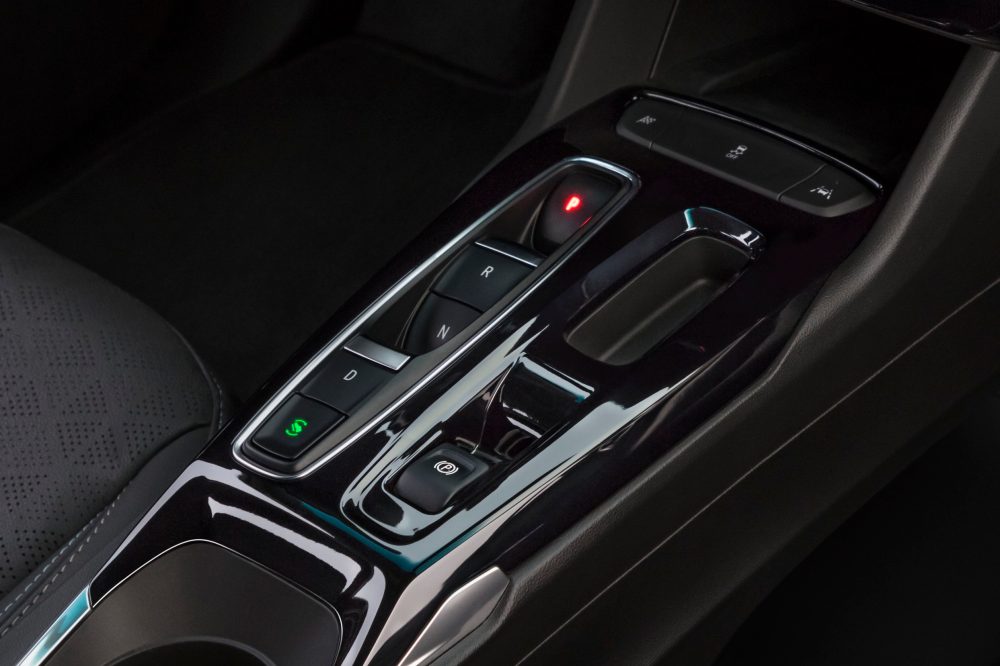
No stick shift
The anachronistic stick shifter has been consigned to the dustbin of history; a set of more intuitive buttons control the car now. One pedal driving now has a dedicated toggle that will retain its setting between starts, one of the most common requested updates. Sport mode, traction control, and lane keep assist buttons are above.
Wireless charging and connectivity
A phone pouch to the right of the transmission selector buttons provides standard wireless charging. Wireless Apple CarPlay and Android Auto also come standard, allowing us to finally rid ourselves of phone cables in the car.
Better cup holders
The cup holders have also been moved back, and now sit directly in front of the armrest.
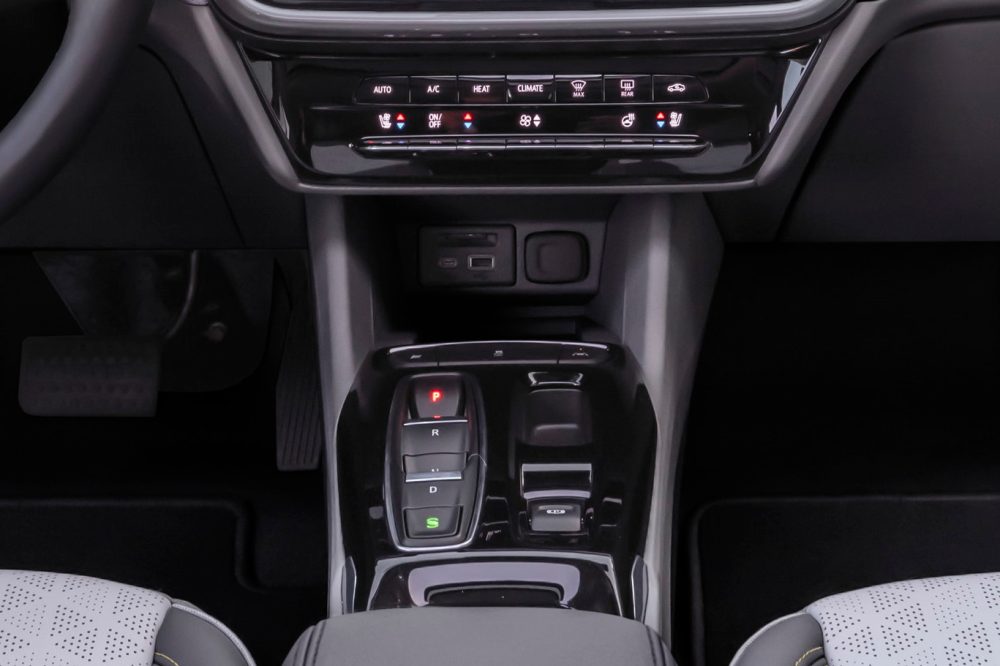
There are also USB-A and USB-C ports for faster wired charging, if that’s still your thing. There’s another slot just above, which looks like it might be for an SD-Card. The 12V accessory outlet remains, although there’s no 120V AC outlet to be found.
Revamped climate controls give an elegant feel

The HVAC controls have a premium look, now fully separated from the infotainment display. This returns to the discrete buttons that many owners preferred. Being able to get haptic feedback by touching physical buttons means that you can change things without your eyes leaving the road – a task difficult with touchscreens.
Modernized instrument panel and steering wheel
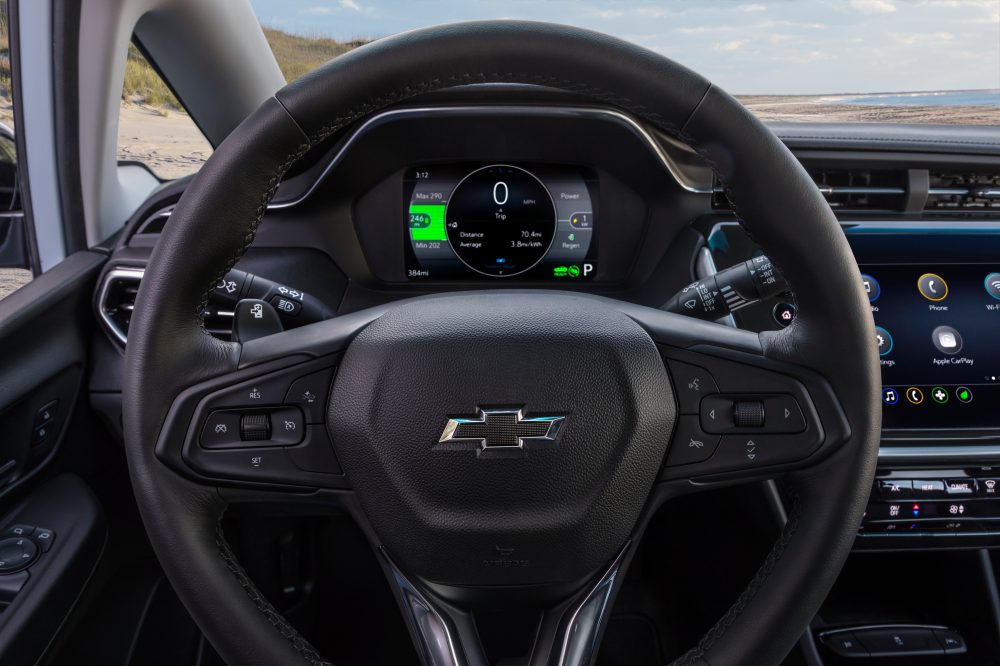
GM is claiming a brand-new instrument panel, but it looks very similar to before. If anything, it’s a little shorter, with the battery and power gauges compressed. For those too lazy to look at the infotainment system, a clock has been added in the upper left.
Upgraded steering wheel
The steering wheel is slightly upgraded. There is now a jog wheel on the right and a similar toggle wheel on the left. The EUV sports a glowing light on the top if you have Super Cruise. The regen-on-demand paddle now peeks up from behind the left side, begging to be used. The bottom of the wheel is a bit flatter, affording slightly more legroom when getting in and out.
Much more comfortable seating
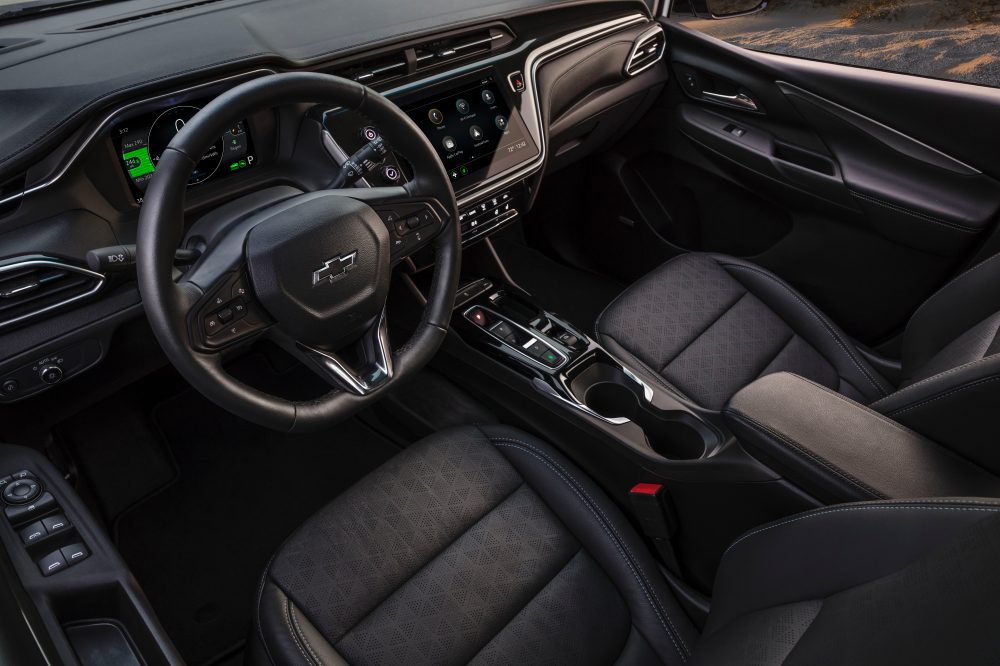
Incredibly important – and finally addressing the most common complaint from the original Bolt EV – much more comfortable seating. The front seats have been entirely redesigned, with much more cushion and proper side and adjustable lumbar support. The driver side now has power adjustments. The center armrest is longer, with cupholders moved further back than before. It all just looks and feels significantly better and more premium.
And more!
Both models will have an optional sunroof, with a special panoramic sunroof available on the Bolt EUV launch edition. Unfortunately, no pictures were made available of that.
Eagle-eyed readers will also notice that the trunk is slimmer on the EUV, removing the “side teeth” of the lights that many previous owners bumped their heads on. There also appears to be a matte black bumper guard.
Slightly different rim options from the 2017-2021 models, with a bit more of a spiraled feel. This, along with the sleek contour lines and creases, gives a sense of motion even when the vehicle is standing still.
What’s new for the Bolt EUV?
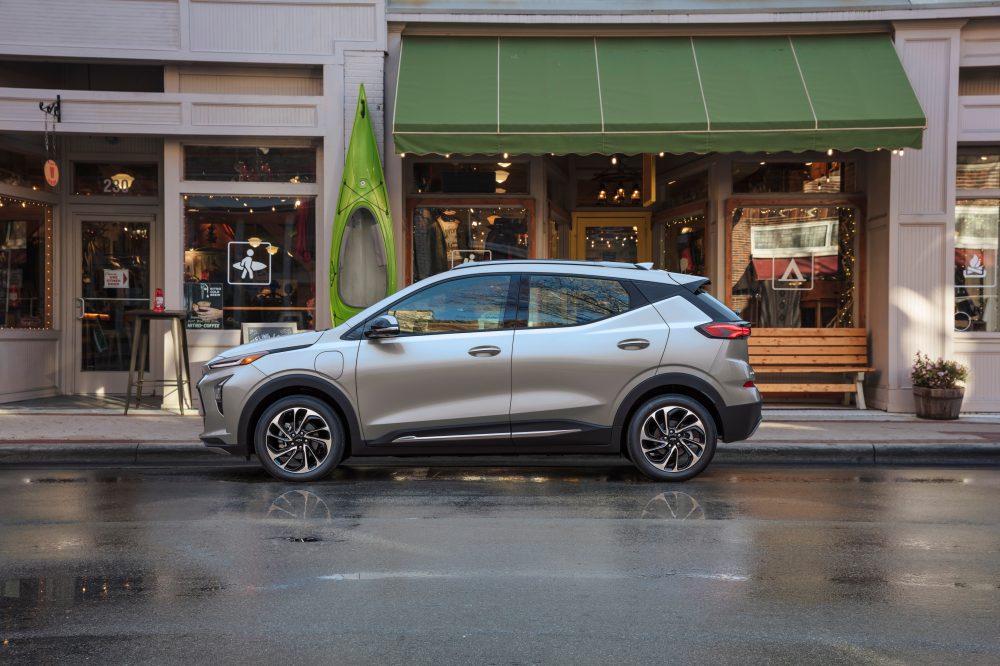
It’s longer
The brand new Bolt EUV has a body that is 6” longer than the EV (169.5″ vs 163.2″), ironically giving it a bit more of a sedan look, less stubby than the EV. Three of those inches go to the rear seat which increases from 36.0” to 39.1” (the 1st gen had 36.5”). This also extends the wheelbase from 102.4” to 105.3”.
Better front end
The front seats and trunk are the same, so the other 3” must be in the front end of the car, extending the nose slightly. A desire for more back seat space in a utility-classified vehicle was made clear during the aforementioned customer feedback sessions. Note that this increase in length adds almost 100lbs to the weight, so the performance will be slightly less than the EV.
Same height and width
While GM is quick to call the Bolt EUV “taller” and “wider” than the EV, it’s only 0.2” in both – so unless you’re pulling out a ruler, it’s effectively the same. The EV is 63.4”, while the EUV is 63.6” tall (compared to 62.8″ previously). For width, we have 69.5” for the EV (same as before), and 69.7” for the EUV.
Premier embedded navigation
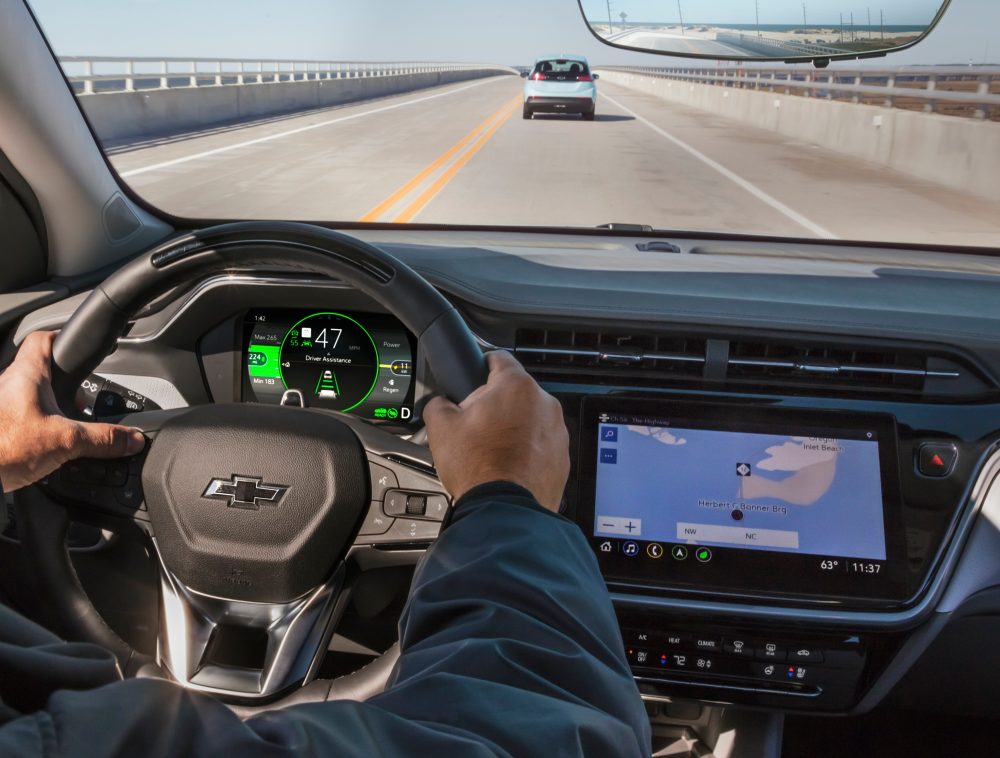
The premier edition of the Bolt EUV will have optional navigation built into the infotainment system. Keep in mind, with Android Auto and Apple CarPlay being wireless, you can use your choice of navigation apps on any version of both the EV and EUV.
Unique styling
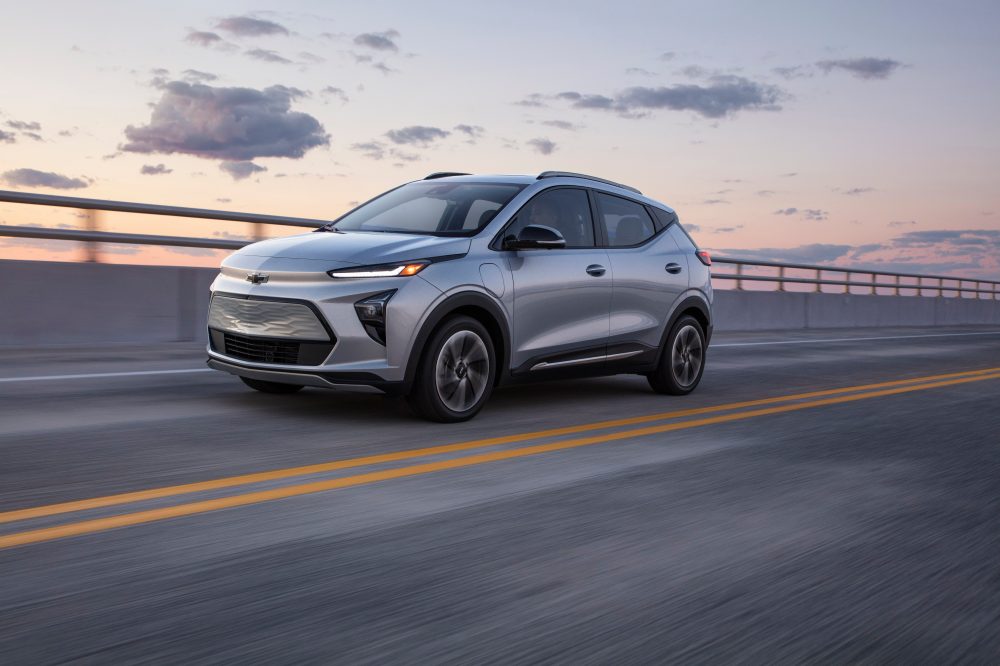
No exterior metal body panels are shared with the Bolt EV. An entirely different body gives subtly unique styling differences, appearing a bit more muscular and sleeker.
Super Cruise!
Other than the slight increase in the rear seat, perhaps the biggest difference with the EUV is the optional Super Cruise. This finally gives the Bolt adaptive cruise control – a feature conspicuously missing from the first generation to the perplexity of many Volt owners.
GM’s first EV with Super Cruise
This is not only the first Chevrolet to carry it, but also the first GM electric vehicle with it. Unlike the Cadillac, however, it will not have the Enhanced Super Cruise with lane change ability. Only standard Super Cruise with lane centering and adaptive cruise control will be available. A combined visible and infra-red camera peeks out from the top of the steering column to ensure that the driver is still looking forward and paying attention.
What has not changed?
Building on the success of the first generation, both the EV and EUV keep the fundamentals the same as the first generation. Everything is pretty much in the same place, and both the EV and EUV share the same propulsion components as before.
Keeping the same core
This includes the single permanent magnet 3 phase AC 150kW motor with 200hp and 266 ft-lb / 360nm of torque. Due to the weight of the EV being almost the same, expect about the same performance feel (sub-7 seconds 0-60), with a little bit less for the EUV due to the increased weight.
The “transmission” is the same single speed fixed 7.05:1 gear reduction.
The 17” Michelin Energy Saver A/S 215/50R17 wheels have stuck around, with the same rotors, brakes, ABS, regen first-braking, and traction control.
Similar front row and trunk and towing
The size of the front seat and trunk are pretty much the same as before, even in the EUV.
Sadly, the EV and EUV will be “carrying over the same towing capacity” as the first generation Bolt EV according to GM – that is to say: none. While towing is possible, it’s not rated for it. This is unsurprising considering the powertrain has not changed.
No battery or range upgrade
Last, and certainly not least – and against the hope of many – it has the same 66kWh battery as the first generation. However, it is being listed as 65kWh; presumably now with 1kWh as buffer. This might be due to the ongoing recall for the 2017-2019 models as an added measure of safety.
The improved styling might also have lead to a bit more aerodynamic efficiency, which the original Bolt wasn’t great at. The EV gets to keep the same 259-mile EPA-rated warm-weather range as before; the heavier EUV gets a slightly lower 250 miles. DC Fast charging is finally standard, but retaining the same 55kW rate and charge profile as before. The EV will get the same 100 miles in 30 minutes (ideal warm weather charging from below 25%), while the EUV gets 95 miles.
Similar road trip ability
The 2020 update did slightly speed up fast charging with a better charging profile, and cold weather DCFC is 50% faster than before. Nothing has changed there; however, GM is also working with EVGo to deploy “thousands” more fast charging stations across the country to assist with road trips. OTA will be available for infotainment only, but if the first generation is any indication, don’t expect any updates.
The new Bolts also keep the same visor and rearview mirror configuration (with optional video rear view), unfortunately still with the lack of homelink.
How do we get it and what’s the price?
Chevrolet, understanding the current plight, has created a brand new ChevyMyWay.com showroom-like virtual studio and shopping experience. Customers will be able to virtually visit and check out the EV and EUV there. Also offered will be live group tours and optional 1:1s as well. Prospective owners can place their pre-orders there or on Chevrolet.com.
GM’s new “Everyone in” campaign
Affordability has always been critical – and they want to make it more attainable for everyone.
The Bolt EV starts at $31,995, with the Bolt EUV starting at $33,995.
There will also be a special (limited production) launch edition Bolt EUV $43,495, which includes Super Cruise (usually a $2,500 option), a Panoramic Sunroof, Special Badging, and the Illuminated charge port. This edition will be the first to be produced.
What’s great is they’ll be available very soon – both vehicles start production later this spring and will have availability in the early summer. Because of the shared components between the two, they will be able to pivot the proportions to meet demand, up to 25% of one and 75% of the other. They are targeting being able to produce more of both than they did with the first generation.
Electrek’s Take
It would have been nice to see faster DCFC charging, a larger battery with longer range, AWD, and towing capacity on the EUV. GM has clearly chosen to focus on affordability while leaving those upgrades to their new Ultium line. This was entirely expected, but it didn’t stop us from hoping for more.
The upgraded level 2 charging is moderately useful. Yes, it’ll help for multi-EV households with only a single home charging cord. Sure you’ll get a few more miles while eating dinner, but that’s a small percentage of owners.
They’ve hit the sweet spot
The fact of the matter is that they hit the sweet spot with the Bolt already. The range is more than enough, and 90% of owners only charge at home or work, so never, or rarely ever, use fast charging. The only thing missing was the features. You can have the best performing car in the world, but if it doesn’t feel good, nobody is going to want it. They have definitively fixed this with the refresh.
Potentially fantastic value
If the $7,000 credits come back, that will propel the Bolt into a $24,995 starting price. With included home charger and install, this is a frankly fantastic value. Adding 400,000 more EV credits will more than triple the current number sold. Without that, however, it may be a tougher sell with the competition, but it will still stand up well.
The EV and EUV are almost identical. With only a $2,000 difference between the two, it will be interesting to see what the purchasing split will be. If the credit comes back, I expect a lot more people will go with the EUV with additional options; the EV will be more barebones and budget focused. Without the credit, I expect EV sales to be very low.
For those looking for a good deal now, the current inventory of Bolt EVs need to “sell down.” Since the prices are dropping on the improved newer models, expect some immediate blowout sales for 2020 and 2021 inventory
Improved dealership situation required
Chevrolet has a lot of work to do on the buying experience. Only about 1,300 of the roughly 3,000 Chevrolet dealerships were previously selling the Bolt. While more than 99% have opted to continue, they need to get a lot more dealers on board. Historically, most dealers provided very little information and poor support. GM has recognized that this is a weak spot, and has pledged to improve this significantly. This will be critical, and only time will tell if they succeed.
It’s very impressive that they are now trying to make the ownership experience a lot simpler. Just buy the car, and don’t worry about how you’re going to charge it. I think that’s very smart. Hopefully they’ll offer an upgrade credit of $500-750 if you already have a home charging setup. I think this will really help adoption.
What I’m most happy with, however, is the redesigned interior and sleeker look. It finally looks like a vehicle worth the price that you’re paying for it. The previous generation felt cheap inside. The plastic and sharply contrasting interior never sat well with me. The all-black interior seen in the EV pictures just looks sexy. It finally feels like it has become a real car that GM wants to sell. Let’s hope people want to buy it.
What do you think? Did Chevrolet knock it out of the part, or will this be a lackluster change? Let us know in the comments below!
FTC: We use income earning auto affiliate links. More.
https://www.youtube.com/watch?v=h9HKT8CitPQ&feature=youtu.be
